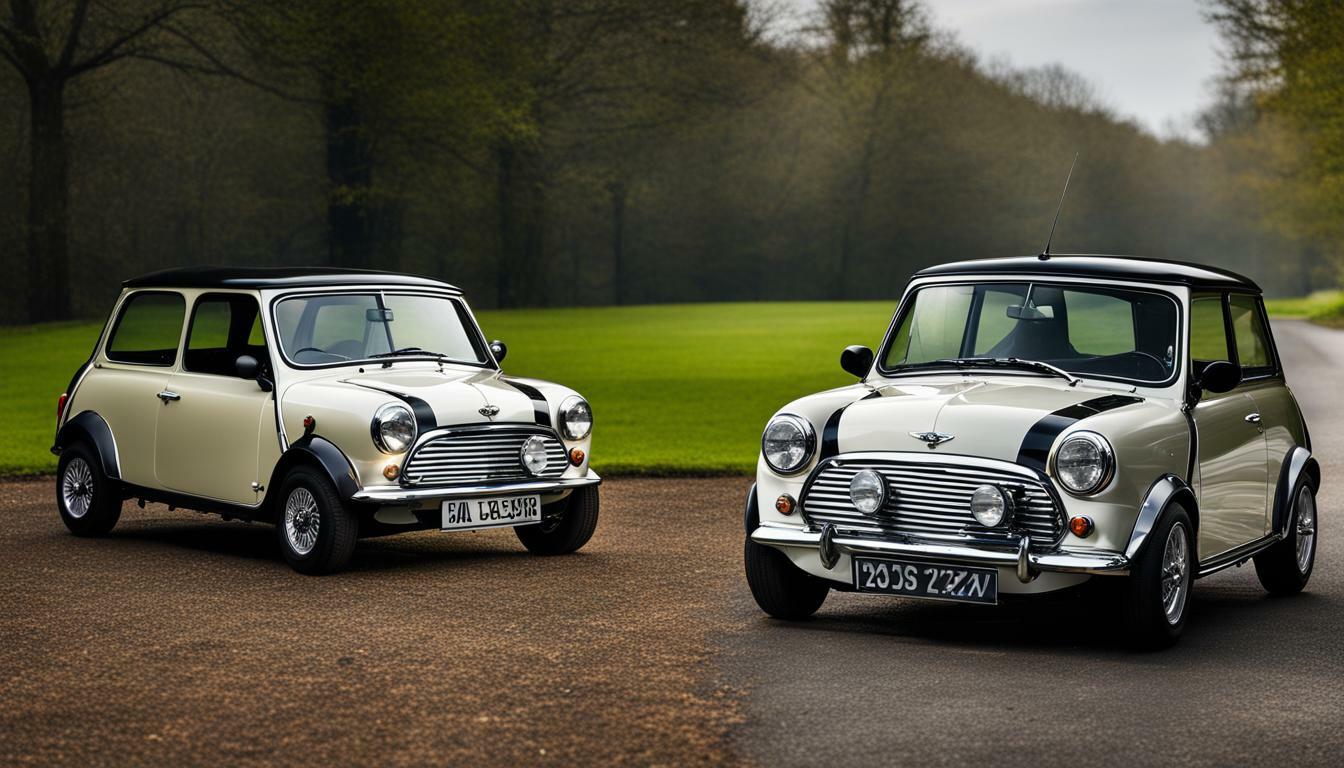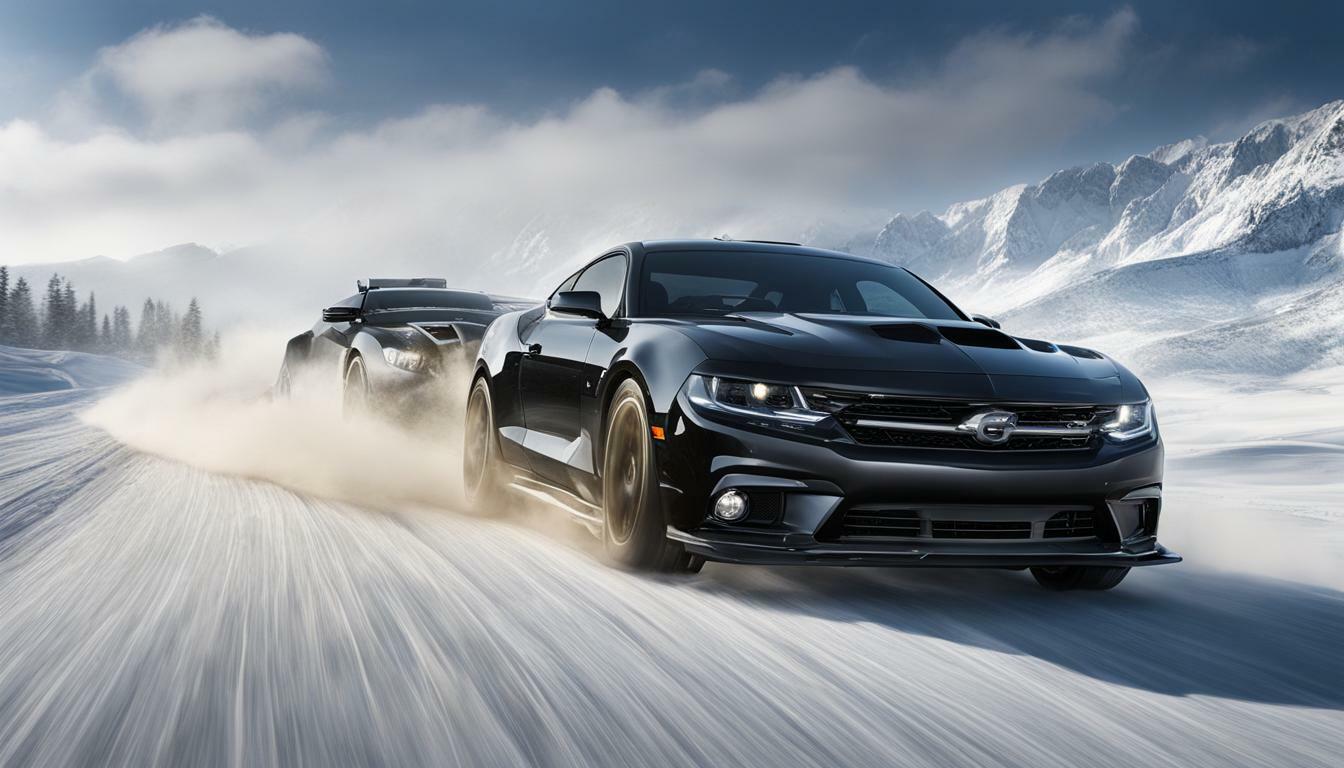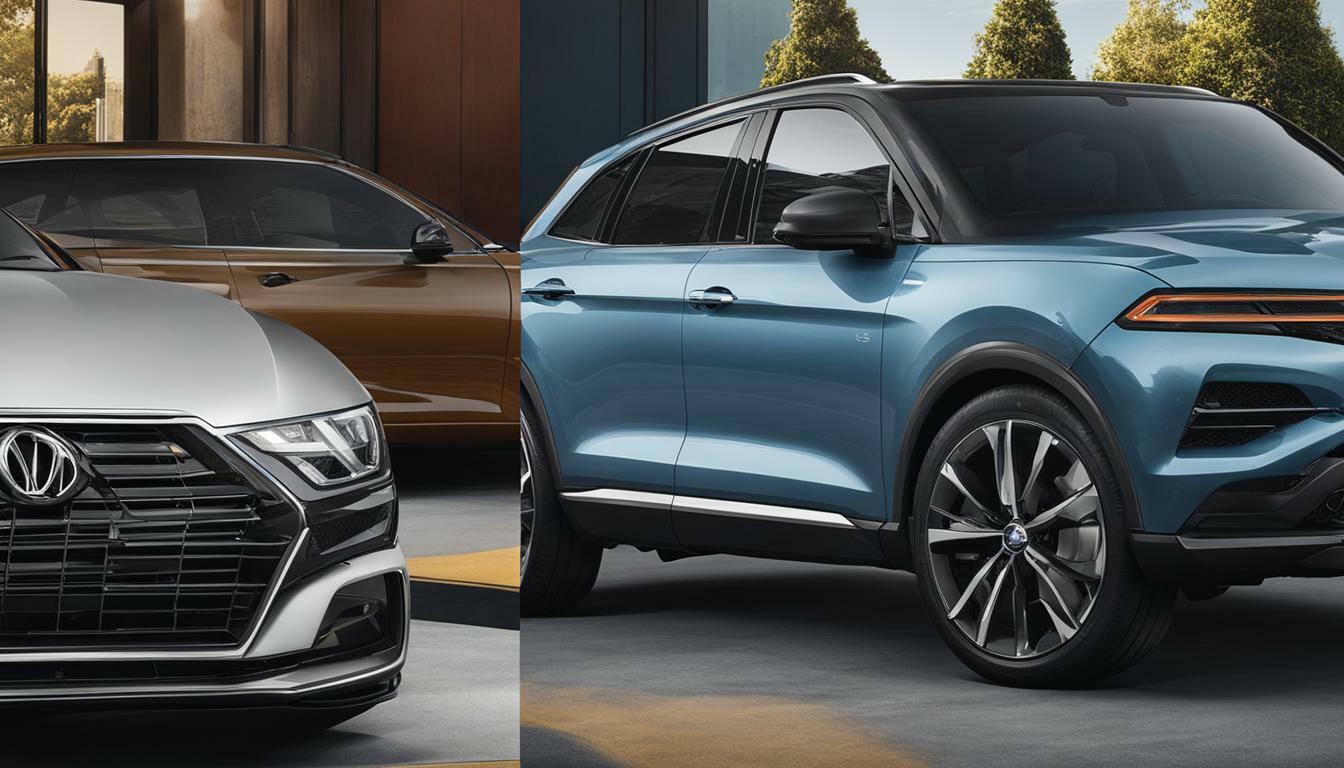For car enthusiasts around the world, Mini Coopers are an iconic symbol of style, personality, and performance. Over the years, Mini Coopers have undergone significant changes, from the classic models of the 1960s to the modern versions that we see on the roads today. In this article, we will explore the key differences between Classic Mini Coopers and their modern counterparts, examining their features, specifications, design elements, performance aspects, and historical significance.
Key Takeaways
- Classic Mini Coopers and Modern Mini Coopers differ significantly in terms of features, specifications, design elements, performance, and history.
- Classic Mini Coopers are known for their compact size, unique body design, and charming interior elements, while modern versions have evolved to meet contemporary driver demands with advancements in technology, comfort, safety, and performance.
- The design and styling of Classic Mini Coopers and Modern Mini Coopers vary considerably, with differences in exterior aesthetics, interior layouts, color options, and notable design elements.
- Both Classic Mini Coopers and Modern Mini Coopers offer a unique driving experience, with variations in engine options, acceleration, handling, fuel efficiency, and overall performance.
- Classic Mini Coopers hold a special place in automotive history and continue to be celebrated by car enthusiasts worldwide.
Features and Specifications of Classic Mini Coopers
Classic Mini Coopers have long been recognized for their distinct features and specifications that set them apart from modern versions. Despite their compact size, these vehicles offer an impressive array of features that have made them a favorite among car enthusiasts.
| Feature | Specification |
|---|---|
| Body Design | The Classic Mini Cooper’s boxy, streamlined exterior design makes it one of the most recognizable vehicles on the road. It boasts a simple, yet eye-catching look, featuring a chrome grille, round headlights, and a compact body style. |
| Interior | The interior of a Classic Mini Cooper is cozy yet functional, with bucket seats and space-saving features such as a center-mounted speedometer. Despite its diminutive size, the Classic Mini Cooper offers plenty of storage options and legroom for the driver and passengers. |
| Engine and Performance | Classic Mini Coopers are powered by a range of engine options, including the legendary 1275cc engine that delivers impressive acceleration and exceptional handling. Their small, lightweight bodies make them incredibly agile and nimble, making them ideal for urban driving. |
| Technology | While Classic Mini Coopers lack modern technology features, they make up for it with their simplicity and charm. However, they do come with some features that were advanced for their time, such as disc brakes and hydrolastic suspension. |
| Safety | Classic Mini Coopers do not have the same level of safety features as modern vehicles, but they do come with some basic safety elements, such as seat belts and a sturdy body frame. |
Overall, Classic Mini Coopers are known for their iconic design, exceptional performance, and charming simplicity. All of these features, combined with their rich history and cultural significance, make them a truly unique and treasured classic car.
Features and Specifications of Modern Mini Coopers
Modern Mini Coopers have come a long way since their Classic predecessors. They offer an array of features and specifications that cater to the needs and wants of contemporary drivers.
Design
The design of modern Mini Coopers has evolved to meet the demands of the modern-day driver. They feature a sleeker and more aerodynamic body, with a lower hood and sharper lines. The interior has also been upgraded with more advanced technology and modern finishes. Additionally, there are now more color and pattern options available than ever before.
Features
Modern Mini Coopers are packed with features that are designed to make driving more comfortable and convenient. They often come equipped with advanced safety features, such as lane departure warning systems and forward collision warning systems. Additionally, many modern Mini Cooper models have a larger infotainment system, which can include features such as Apple CarPlay and Android Auto.
Specifications
| Model | Engine | Horsepower | Torque | MPG (city/highway) |
|---|---|---|---|---|
| Cooper | 1.5L 3-cylinder | 134 hp | 162 lb-ft | 28/36 |
| Cooper S | 2.0L 4-cylinder | 189 hp | 207 lb-ft | 23/32 |
| John Cooper Works | 2.0L 4-cylinder | 228 hp | 258 lb-ft | 23/31 |
The modern Mini Cooper comes with a range of engine options, with the base model featuring a 1.5L, 3-cylinder engine that produces 134 horsepower and 162 lb-ft of torque. The Cooper S, on the other hand, features a 2.0L, 4-cylinder engine that produces 189 horsepower and 207 lb-ft of torque. For those looking for maximum performance, the John Cooper Works model features a 2.0L, 4-cylinder engine that produces 228 horsepower and 258 lb-ft of torque.
In terms of fuel efficiency, the modern Mini Cooper is a great option for those looking for a car that is both stylish and practical. The Cooper gets an estimated 28/36 MPG in the city and on the highway, while the Cooper S gets an estimated 23/32 MPG in the city and on the highway. The John Cooper Works model gets an estimated 23/31 MPG in the city and on the highway.
Overall, the modern Mini Cooper is a great car for those looking for a stylish and practical option that is packed with features.
Design and Styling of Classic and Modern Mini Coopers
The design and styling of Classic Mini Coopers and their modern counterparts have undergone significant changes over the years. While the original Mini Cooper was designed in the 1950s by Sir Alec Issigonis, BMW acquired the brand in 2000 and introduced the modern Mini Cooper in 2001. Let’s delve into the design elements that define each version.
Classic Mini Cooper Design
The Classic Mini Cooper was built with a unique body design that prioritized functionality and minimized excess. Its signature compact size and efficient use of space made it an ideal car for city driving. The rounded shape of the car, with its curved front and rear end, gave it a charming and retro feel. It also featured a distinctive grille, circular headlights, and a sliding side-window. The interior was similarly minimalistic, with a simple dashboard and cozy seating for four.
The Classic Mini Cooper came in a range of color options, including the iconic British Racing Green and bright red. Its design was simple yet effective, and it continues to be a beloved classic car around the world.
Modern Mini Cooper Design
The modern Mini Cooper, while still recognizable as a Mini, has undergone significant updates to meet the demands of modern drivers. It is larger than the Classic Mini Cooper and features a more angular body design. The front grille is bigger and more prominent, and the headlights are elongated. The interior is more spacious and comfortable, featuring a modern dashboard and updated technology.
The modern Mini Cooper comes in a wide range of color options, from classic British Racing Green to bold shades like Electric Blue and Chili Red. It also offers various design packages, allowing drivers to customize the car to their preferences. From the classic design of the Union Jack roof to the sleek John Cooper Works body kit, the modern Mini Cooper has something for everyone.
Overall, while the Classic and Modern Mini Cooper may look quite different, they both embody the spirit of the Mini brand. They are both designed to be efficient and practical for city driving, while still offering plenty of personality and style. Whether you prefer the retro charm of the Classic Mini Cooper or the updated amenities of the modern Mini Cooper, both versions offer their own unique appeal.
Performance and Legacy of Classic and Modern Mini Coopers
Both Classic and Modern Mini Coopers are known for their exceptional performance and unique driving experience. Classic models were designed with agility and speed in mind, making them perfect for navigating the narrow and winding roads of Europe. They were also known for their fuel efficiency, thanks to their compact size and efficient engines.
Modern Mini Coopers, on the other hand, boast a range of advanced features that improve their driving performance. With more powerful engines, responsive steering, and advanced suspension systems, they offer a smoother and more comfortable ride. Additionally, they come equipped with advanced safety features like lane departure warning, rearview cameras, and automatic emergency braking systems.
Classic Mini Cooper Performance
Classic Mini Coopers were built for speed and agility. Their lightweight design and responsive steering made them perfect for zipping through tight corners and narrow streets. They also featured efficient engines and manual transmissions, which helped them achieve exceptional fuel efficiency. In fact, some models were capable of achieving up to 50 miles per gallon, making them one of the most fuel-efficient cars of their time.
Their diminutive size also made them remarkably maneuverable, allowing drivers to weave through traffic and easily find parking spaces. Because of their racing pedigree, Classic Mini Coopers were also popular among car enthusiasts who valued their speed and handling in track settings.
Modern Mini Cooper Performance
Modern Mini Coopers are known for their advanced driving performance and smooth ride. They come equipped with powerful engines that deliver impressive acceleration and speed. Some models are capable of going from 0 to 60 miles per hour in less than 6 seconds. They also feature advanced suspension systems that improve handling and create a more comfortable ride.
In addition to their impressive performance, Modern Mini Coopers also come equipped with advanced safety features. These features include adaptive cruise control, automatic emergency braking, and rearview cameras, among others.
Classic Mini Cooper History
Classic Mini Coopers were first introduced in 1959 by the British Motor Corporation (BMC). Their unique design, which featured a transverse engine and front-wheel drive, was revolutionary for its time. The Mini Cooper quickly became popular in Europe and was soon exported to other markets around the world.
Its popularity was further boosted by its success in racing competitions, including the prestigious Monte Carlo Rally. The Cooper S model, which featured a more powerful engine and improved handling, was particularly successful in racing. Its victory in the 1964 Monte Carlo Rally brought the Mini Cooper to the attention of car enthusiasts worldwide.
Today, Classic Mini Coopers are highly sought after by collectors and car enthusiasts alike. Their distinctive design and rich history make them a beloved part of automotive heritage.
Conclusion
In conclusion, when comparing Classic Mini Coopers to their modern versions, there are many similarities and many differences. Classic Mini Coopers are iconic and have a unique charm that is hard to replicate. Their compact size, unique body design, and charming interior elements are just a few of the features that make them stand out. On the other hand, modern Mini Coopers have advanced to meet the needs of contemporary drivers, with improvements in technology, comfort, safety, and performance. However, they have managed to do so without losing the essence and characteristics that define a Mini Cooper.
Which Version is Better?
There is no definitive answer to this question, as it ultimately depends on personal preference. If you are a fan of classic cars and enjoy the nostalgia and charm of driving a vintage vehicle, a Classic Mini Cooper may be the perfect fit for you. However, if you are looking for a more modern and updated driving experience, a modern Mini Cooper may be the better choice. Both versions are reliable and fun to drive, with their own unique advantages and disadvantages.
Overall, whether you prefer the classic styling and charm of the original Mini Cooper or the modern amenities and performance of their successors, there is no denying that both versions have captured the hearts of car enthusiasts worldwide.
FAQ
Q: What are the key differences between Classic Mini Coopers and modern versions?
A: Classic Mini Coopers and modern versions differ in various aspects such as features, specifications, design, and performance. Classic Mini Coopers embody a more vintage charm, with their compact size and unique design elements, while modern Mini Coopers offer advanced technology, enhanced comfort, and improved performance.
Q: What are some notable features and specifications of Classic Mini Coopers?
A: Classic Mini Coopers are known for their compact size, charming interior elements, and distinctive body design. They often feature manual transmissions, efficient engines, and a simplicity that appeals to enthusiasts.
Q: What are the features and specifications that define modern Mini Coopers?
A: Modern Mini Coopers have evolved to meet the demands of contemporary drivers. They incorporate advanced technology, including touchscreen displays, navigation systems, and connectivity options. They also offer improved safety features, more spacious interiors, and efficient engines.
Q: How has the design and styling of Classic and Modern Mini Coopers changed over time?
A: Classic Mini Coopers are renowned for their iconic exterior aesthetics and unique design elements. On the other hand, modern Mini Coopers have undergone significant design updates, featuring a sleeker and more aerodynamic look. Interior layouts have also been reimagined to provide enhanced comfort and convenience.
Q: What can you tell me about the performance of Classic and Modern Mini Coopers?
A: Classic Mini Coopers offered nimble handling and efficient engines, making them ideal for urban driving. Modern Mini Coopers have improved performance capabilities, with more powerful engines, better acceleration, and advanced suspension systems. Both versions have their own appeal, catering to different driving preferences.
Q: Is there any historical significance associated with Classic Mini Coopers?
A: Classic Mini Coopers hold a special place in automotive history. They were first introduced in the 1950s and quickly gained popularity for their unique design, efficient performance, and affordability. Classic Mini Coopers have often been associated with iconic figures and have left a lasting impact on automotive culture.



